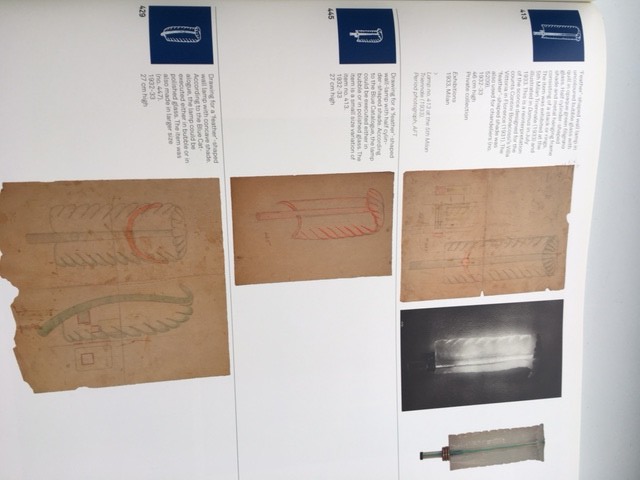Look Closely Again And Again
Published on: By Gail Garlick

Last week, I was very excited to see a larger version of appliques that I have in my home. They were shown in an auction catalogue and attributed to the influential Italian architect Tomasso Buzzi. Buzzi was friends and colleagues with Gio Ponti during the 1920’s and 1930’s. I’d bought my appliques, a single leafed pair, a dozen years ago from a dealer who knows Buzzi’s work well. She hadn’t said the sconces were by Buzzi when I bought them. My sense is that they are by Barovier but this attribution of Buzzi made me look into it further.
The auction catalog sited page 399 in the Marino Barovier book “Tomasso Buzzi at Venini” by Skira 2014 as it’s documentation that the appliques were legitimately by Buzzi. This large and detailed book regarding the work of Tomasso Buzzi accompanied the splendid Buzzi exhibit that year in Venice.
During the summer of 2014 I was in Venice, and I went to see the exhibit a couple of times. It was exquisite! Set at the renowned Fondazione Giorgio Cini on the island of San Giorgio Maggiore, it was a joy to behold. What Buzzi produced for Venini is amazing and I spent hours looking and studying. Somewhat minimalist, perfectly scaled, exquisitely colored, finely made, these pieces are remarkable examples of Murano glass. While I hoped my appliques were by Buzzi, my gut told me that the auction house attribution wasn’t right. While I love my little appliques I don’t see the hand of Buzzi in them. Still the question needed further investigation. Opening my copy of the exhibition catalogue to page 399 here is what I saw.
Page 399 Tomasso Buzzi BookThe page consists of text, drawings and two small vintage photos. The photos show very different pieces of glass from the large appliques you see at the top of the post. Clearly the images on page 399 aren’t the same appliques. While both are leaves, how those leaves are formed and executed differs dramatically. Buzzi’s seem to be of a single piece of glass with cut scalloped edges. The leaves on the others are separately applied pieces with overlapping parts and deep ruffling. The brass mounts are also quite different. The mounts on page 399 are three stacked rings fully in the round. Those on the pair at the top of this post look like this.
a wide band incised with lines. I’ve developed hyper attention to detail and a healthy dose of skepticism from decades of continuous education. Even so I further consulted The Venini Catalog Raissone as well as sending off an email to my dealer friend in Italy. He agreed with me that the appliques being attributed to Buzzi don’t seem to be by Buzzi. So unless new information surfaces to convince me that they are indeed by Buzzi, I am not a believer.
It’s important to look carefully. and it’s important to check the actual documentation. More often than one would think documentation may not be reliable. Either the item in question does not appear at all in the book or it’s a completely different item shown on that page. As to our ability to clearly see what we are looking at I offer you this anecdote.
A few years ago two ladies were helping me set tables for a party. With 20 people coming I was using two different sets of flatware. When I noticed they had mixed the two flatware patterns together for a single place setting, I explained that I wanted each place setting in a single pattern. They didn’t seem to understand what I was talking about. So I showed them a fork from each pattern and asked them if they could see the difference. They could not. To them the forks were exactly the same. My experience in looking and seeing was not theirs and what I could readily see, they could not. Up until that moment it had never struck me that we all have different histories of looking and seeing. What I see may be radically different from what someone else sees.
When we look at things on the internet we lose many of the cues we need. Seeing in person is always preferable. Also we seem to lose our ability to be skeptical. When it says designed by so and so, we take it as fact. We don’t question. After all it’s on the screen. We need to look longer and more carefully and we need to be skeptical. And always check the documentation by going to it’s original source.


